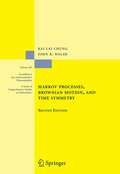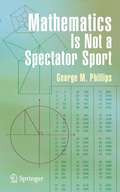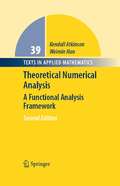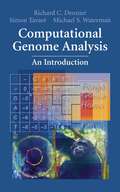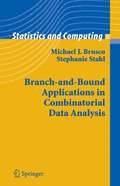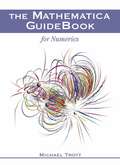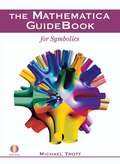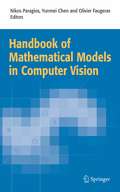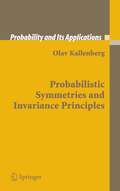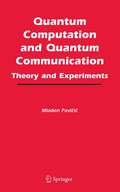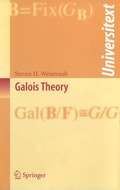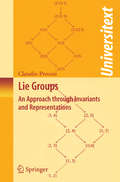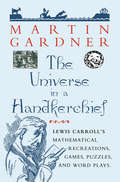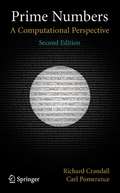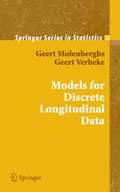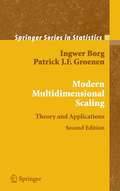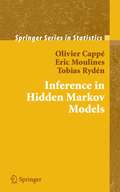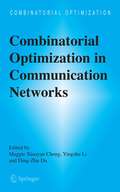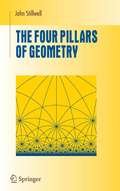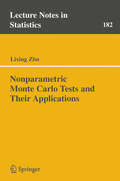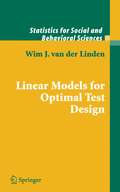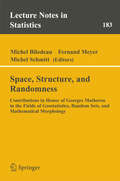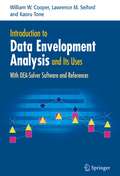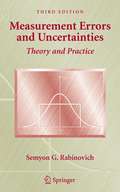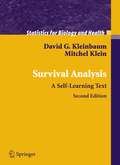- Table View
- List View
Markov Processes, Brownian Motion, and Time Symmetry (Grundlehren der mathematischen Wissenschaften #249)
by Kai Lai Chung John B. WalshFrom the reviews of the First Edition: "This excellent book is based on several sets of lecture notes written over a decade and has its origin in a one-semester course given by the author at the ETH, Zürich, in the spring of 1970. The author's aim was to present some of the best features of Markov processes and, in particular, of Brownian motion with a minimum of prerequisites and technicalities. The reader who becomes acquainted with the volume cannot but agree with the reviewer that the author was very successful in accomplishing this goal…The volume is very useful for people who wish to learn Markov processes but it seems to the reviewer that it is also of great interest to specialists in this area who could derive much stimulus from it. One can be convinced that it will receive wide circulation." (Mathematical Reviews) This new edition contains 9 new chapters which include new exercises, references, and multiple corrections throughout the original text.
Mathematics Is Not a Spectator Sport
by George PhillipsCompared to other popular math books, there is more algebraic manipulation, and more applications of algebra in number theory and geometry Presents an exciting variety of topics to motivate beginning students May be used as an introductory course or as background reading
Theoretical Numerical Analysis: A Functional Analysis Framework (Texts in Applied Mathematics #39)
by Kendall Atkinson Weimin HanMathematics is playing an ever more important role in the physical and biological sciences, provoking a blurring of boundaries between scienti?c disciplines and a resurgence of interest in the modern as well as the cl- sical techniques of applied mathematics. This renewal of interest, both in research and teaching, has led to the establishment of the series: Texts in Applied Mathematics (TAM). Thedevelopmentofnewcoursesisanaturalconsequenceofahighlevelof excitement on the research frontier as newer techniques, such as numerical and symbolic computer systems, dynamical systems, and chaos, mix with and reinforce the traditional methods of applied mathematics. Thus, the purpose of this textbook series is to meet the current and future needs of these advances and to encourage the teaching of new courses. TAM will publish textbooks suitable for use in advanced undergraduate and beginning graduate courses, and will complement the Applied Ma- ematical Sciences (AMS) series, which will focus on advanced textbooks and research-level monographs.
Computational Genome Analysis: An Introduction
by Richard C. Deonier Simon Tavaré Michael S. WatermanThis book presents the foundations of key problems in computational molecular biology and bioinformatics. It focuses on computational and statistical principles applied to genomes, and introduces the mathematics and statistics that are crucial for understanding these applications. The book features a free download of the R software statistics package and the text provides great crossover material that is interesting and accessible to students in biology, mathematics, statistics and computer science. More than 100 illustrations and diagrams reinforce concepts and present key results from the primary literature. Exercises are given at the end of chapters.
Branch-and-Bound Applications in Combinatorial Data Analysis (Statistics and Computing)
by Michael J. Brusco Stephanie StahlThis book provides clear explanatory text, illustrative mathematics and algorithms, demonstrations of the iterative process, pseudocode, and well-developed examples for applications of the branch-and-bound paradigm to important problems in combinatorial data analysis. Supplementary material, such as computer programs, are provided on the world wide web. Dr. Brusco is an editorial board member for the Journal of Classification, and a member of the Board of Directors for the Classification Society of North America.
The Mathematica GuideBook for Numerics
by Michael TrottProvides the reader with working knowledge of Mathematica and key aspects of Mathematica's numerical capabilities needed to deal with virtually any "real life" problem Clear organization, complete topic coverage, and an accessible writing style for both novices and experts Website for book with additional materials: http://www.MathematicaGuideBooks.org Accompanying DVD containing all materials as an electronic book with complete, executable Mathematica 5.1 compatible code and programs, rendered color graphics, and animations
The Mathematica GuideBook for Symbolics
by Michael TrottProvides reader with working knowledge of Mathematica and key aspects of Mathematica symbolic capabilities, the real heart of Mathematica and the ingredient of the Mathematica software system that makes it so unique and powerful Clear organization, complete topic coverage, and an accessible writing style for both novices and experts Website for book with additional materials: http://www/MathematicaGuideBooks.org Accompanying DVD containing all materials as an electronic book with complete, executable Mathematica 5.1 compatible code and programs, rendered color graphics, and animations
Handbook of Mathematical Models in Computer Vision
by Nikos Paragios Yunmei Chen Olivier D. FaugerasAbstract Biological vision is a rather fascinating domain of research. Scientists of various origins like biology, medicine, neurophysiology, engineering, math ematics, etc. aim to understand the processes leading to visual perception process and at reproducing such systems. Understanding the environment is most of the time done through visual perception which appears to be one of the most fundamental sensory abilities in humans and therefore a significant amount of research effort has been dedicated towards modelling and repro ducing human visual abilities. Mathematical methods play a central role in this endeavour. Introduction David Marr's theory v^as a pioneering step tov^ards understanding visual percep tion. In his view human vision was based on a complete surface reconstruction of the environment that was then used to address visual subtasks. This approach was proven to be insufficient by neuro-biologists and complementary ideas from statistical pattern recognition and artificial intelligence were introduced to bet ter address the visual perception problem. In this framework visual perception is represented by a set of actions and rules connecting these actions. The emerg ing concept of active vision consists of a selective visual perception paradigm that is basically equivalent to recovering from the environment the minimal piece information required to address a particular task of interest.
Probabilistic Symmetries and Invariance Principles (Probability and Its Applications)
by Olav KallenbergQuantum Computation and Quantum Communication: Theory and Experiments
by Mladen PavicicThe field of quantum computing has experienced rapid development and many different experimental and theoretical groups have emerged worldwide.This book presents the key elements of quantum computation and communication theories and their implementation in an easy-to-read manner for readers coming from physics, mathematics and computer science backgrounds. Integrating both theoretical aspects and experimental verifications of developing quantum computers, the author explains why particular mathematical methods, physical models and realistic implementations might provide critical steps towards achieving the final goal - constructing quantum computers and quantum networks. The book serves as an excellent introduction for new researchers and also provides a useful review for specialists in the field
Galois Theory (Universitext)
by Steven H. WeintraubGalois theory is a mature mathematical subject of particular beauty. Any Galois theory book written nowadays bears a great debt to Emil Artin’s classic text "Galois Theory," and this book is no exception. While Artin’s book pioneered an approach to Galois theory that relies heavily on linear algebra, this book’s author takes the linear algebra emphasis even further. This special approach to the subject together with the clarity of its presentation, as well as the choice of topics covered, makes this book a more than worthwhile addition to the existing literature on Galois Theory. It will be appreciated by undergraduate and beginning graduate math majors.
Lie Groups: An Approach through Invariants and Representations (Universitext)
by Claudio ProcesiLie groups has been an increasing area of focus and rich research since the middle of the 20th century. In Lie Groups: An Approach through Invariants and Representations, the author's masterful approach gives the reader a comprehensive treatment of the classical Lie groups along with an extensive introduction to a wide range of topics associated with Lie groups: symmetric functions, theory of algebraic forms, Lie algebras, tensor algebra and symmetry, semisimple Lie algebras, algebraic groups, group representations, invariants, Hilbert theory, and binary forms with fields ranging from pure algebra to functional analysis. By covering sufficient background material, the book is made accessible to a reader with a relatively modest mathematical background. Historical information, examples, exercises are all woven into the text. This unique exposition is suitable for a broad audience, including advanced undergraduates, graduates, mathematicians in a variety of areas from pure algebra to functional analysis and mathematical physics.
The Universe in a Handkerchief: Lewis Carroll’s Mathematical Recreations, Games, Puzzles, and Word Plays
by Martin GardnerThis book contains scores of intriguing puzzles and paradoxes from Lewis Carroll, the author of Alice in Wonderland, whose interests ranged from inventing new games like Arithmetical Croquet to important problems in symbolic logic and propositional calculus. Written by Carroll expert and well-known mathematics author Martin Gardner, this tour through Carroll's inventions is both fun and informative.
Prime Numbers: A Computational Perspective
by Richard Crandall Carl B. PomeranceBridges the gap between theoretical and computational aspects of prime numbers Exercise sections are a goldmine of interesting examples, pointers to the literature and potential research projects Authors are well-known and highly-regarded in the field
Models for Discrete Longitudinal Data (Springer Series in Statistics)
by Geert Molenberghs Geert VerbekeThe linear mixed model has become the main parametric tool for the analysis of continuous longitudinal data, as the authors discussed in their 2000 book. Without putting too much emphasis on software, the book shows how the different approaches can be implemented within the SAS software package. The authors received the American Statistical Association's Excellence in Continuing Education Award based on short courses on longitudinal and incomplete data at the Joint Statistical Meetings of 2002 and 2004.
Modern Multidimensional Scaling: Theory and Applications (Springer Series in Statistics)
by I. Borg P. J. GroenenThe first edition was released in 1996 and has sold close to 2200 copies. Provides an up-to-date comprehensive treatment of MDS, a statistical technique used to analyze the structure of similarity or dissimilarity data in multidimensional space. The authors have added three chapters and exercise sets. The text is being moved from SSS to SSPP. The book is suitable for courses in statistics for the social or managerial sciences as well as for advanced courses on MDS. All the mathematics required for more advanced topics is developed systematically in the text.
Inference in Hidden Markov Models (Springer Series in Statistics)
by Olivier Cappé Eric Moulines Tobias RydenThis book is a comprehensive treatment of inference for hidden Markov models, including both algorithms and statistical theory. Topics range from filtering and smoothing of the hidden Markov chain to parameter estimation, Bayesian methods and estimation of the number of states. In a unified way the book covers both models with finite state spaces and models with continuous state spaces (also called state-space models) requiring approximate simulation-based algorithms that are also described in detail. Many examples illustrate the algorithms and theory. This book builds on recent developments to present a self-contained view.
Combinatorial Optimization in Communication Networks (Combinatorial Optimization #18)
by Maggie Xiaoyan Cheng Yingshu Li Ding-Zhu DuThis book gives a comprehensive presentation of cutting-edge research in communication networks with a combinatorial optimization component. The objective of the book is to advance and promote the theory and applications of combinatorial optimization in communication networks. Each chapter is written by an expert dealing with theoretical, computational, or applied aspects of combinatorial optimization.
The Four Pillars of Geometry (Undergraduate Texts in Mathematics)
by John StillwellThis book is unique in that it looks at geometry from 4 different viewpoints - Euclid-style axioms, linear algebra, projective geometry, and groups and their invariants Approach makes the subject accessible to readers of all mathematical tastes, from the visual to the algebraic Abundantly supplemented with figures and exercises
Nonparametric Monte Carlo Tests and Their Applications (Lecture Notes in Statistics #182)
by Li-Xing ZhuA fundamental issue in statistical analysis is testing the fit of a particular probability model to a set of observed data. Monte Carlo approximation to the null distribution of the test provides a convenient and powerful means of testing model fit. Nonparametric Monte Carlo Tests and Their Applications proposes a new Monte Carlo-based methodology to construct this type of approximation when the model is semistructured. When there are no nuisance parameters to be estimated, the nonparametric Monte Carlo test can exactly maintain the significance level, and when nuisance parameters exist, this method can allow the test to asymptotically maintain the level. The author addresses both applied and theoretical aspects of nonparametric Monte Carlo tests. The new methodology has been used for model checking in many fields of statistics, such as multivariate distribution theory, parametric and semiparametric regression models, multivariate regression models, varying-coefficient models with longitudinal data, heteroscedasticity, and homogeneity of covariance matrices. This book will be of interest to both practitioners and researchers investigating goodness-of-fit tests and resampling approximations. Every chapter of the book includes algorithms, simulations, and theoretical deductions. The prerequisites for a full appreciation of the book are a modest knowledge of mathematical statistics and limit theorems in probability/empirical process theory. The less mathematically sophisticated reader will find Chapters 1, 2 and 6 to be a comprehensible introduction on how and where the new method can apply and the rest of the book to be a valuable reference for Monte Carlo test approximation and goodness-of-fit tests. Lixing Zhu is Associate Professor of Statistics at the University of Hong Kong. He is a winner of the Humboldt Research Award at Alexander-von Humboldt Foundation of Germany and an elected Fellow of the Institute of Mathematical Statistics. From the reviews: "These lecture notes discuss several topics in goodness-of-fit testing, a classical area in statistical analysis. … The mathematical part contains detailed proofs of the theoretical results. Simulation studies illustrate the quality of the Monte Carlo approximation. … this book constitutes a recommendable contribution to an active area of current research." Winfried Stute for Mathematical Reviews, Issue 2006 "...Overall, this is an interesting book, which gives a nice introduction to this new and specific field of resampling methods." Dongsheng Tu for Biometrics, September 2006
Linear Models for Optimal Test Design (Statistics for Social and Behavioral Sciences)
by Wim J. van der LindenWim van der Linden was just given a lifetime achievement award by the National Council on Measurement in Education. There is no one more prominent in the area of educational testing. There are hundreds of computer-based credentialing exams in areas such as accounting, real estate, nursing, and securities, as well as the well-known admissions exams for college, graduate school, medical school, and law school - there is great need on the theory of testing. This book presents the statistical theory and practice behind constructing good tests e.g., how is the first test item selected, how are the next items selected, and when do you have enough items.
Space, Structure and Randomness: Contributions in Honor of Georges Matheron in the Fields of Geostatistics, Random Sets and Mathematical Morphology (Lecture Notes in Statistics #183)
by Michel Bilodeau Fernand Meyer Michel SchmittSpace, structure, and randomness: these are the three key concepts underlying Georges Matheron’s scientific work. He first encountered them at the beginning of his career when working as a mining engineer, and then they resurfaced in fields ranging from meteorology to microscopy. What could these radically different types of applications possibly have in common? First, in each one only a single realisation of the phenomenon is available for study, but its features repeat themselves in space; second, the sampling pattern is rarely regular, and finally there are problems of change of scale. This volume is divided in three sections on random sets, geostatistics and mathematical morphology. They reflect his professional interests and his search for underlying unity. Some readers may be surprised to find theoretical chapters mixed with applied ones. We have done this deliberately. GM always considered that the distinction between the theory and practice was purely academic. When GM tackled practical problems, he used his skill as a physicist to extract the salient features and to select variables which could be measured meaningfully and whose values could be estimated from the available data. Then he used his outstanding ability as a mathematician to solve the problems neatly and efficiently. It was his capacity to combine a physicist’s intuition with a mathematician’s analytical skills that allowed him to produce new and innovative solutions to difficult problems. The book should appeal to graduate students and researchers working in mathematics, probability, statistics, physics, spatial data analysis, and image analysis. In addition it will be of interest to those who enjoy discovering links between scientific disciplines that seem unrelated at first glance. In writing the book the contributors have tried to put GM’s ideas into perspective. During his working life, GM was a genuinely creative scientist. He developed innovative concepts whose usefulness goes far beyond the confines of the discipline for which they were originally designed. This is why his work remains as pertinent today as it was when it was first written.
Introduction to Data Envelopment Analysis and Its Uses: With DEA-Solver Software and References
by William W. Cooper Lawrence M. Seiford Kaoru ToneIntroduction to Data Envelopment Analysis and Its Uses: With DEA-Solver Software and References has been carefully designed by the authors to provide a systematic introduction to DEA and its uses as a multifaceted tool for evaluating problems in a variety of contexts. The authors have been involved in DEA's development from the beginning. William Cooper (with Abraham Charnes and Edwardo Rhodes) is a founder of DEA. Lawrence Seiford and Kaoru Tone have been actively involved as researchers and practitioners from its earliest beginnings. All have been deeply involved in uses of DEA in practical applications as well as in the development of its basic theory and methodologies. The result is a textbook grounded in authority, experience and substance.
Measurement Errors and Uncertainties: Theory and Practice
by Semyon G. RabinovichA practical reference on theory and methods of estimating measurement errors and uncertainty for both scientists and engineers in industry and experimental research. Building on the fundamentals of measurement theory, this book offers a wealth of practial recommendations and procedures. It differs from the majority of books in that it balances coverage of probabilistic methods with detailed information on the characterization, calibration, standardization and limitations of measuring instruments, with specific examples from both electrical and mechanical systems. In addition to a general updating to reflect current research, new material in this edition includes increased coverage of indirect measurements, with a new, simpler, more efficient method for this class of measurements.
Survival Analysis: A Self-Learning Text (Statistics for Biology and Health)
by David G. Kleinbaum Mitchel KleinAn excellent introduction for all those coming to the subject for the first time. New material has been added to the second edition and the original six chapters have been modified. The previous edition sold 9500 copies world wide since its release in 1996. Based on numerous courses given by the author to students and researchers in the health sciences and is written with such readers in mind. Provides a "user-friendly" layout and includes numerous illustrations and exercises. Written in such a way so as to enable readers learn directly without the assistance of a classroom instructor. Throughout, there is an emphasis on presenting each new topic backed by real examples of a survival analysis investigation, followed up with thorough analyses of real data sets.
